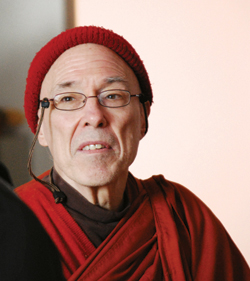 Watch Bhikkhu Bodhi’s retreat here.
Watch Bhikkhu Bodhi’s retreat here.
For American Buddhists, the Theravada tradition has become so narrowly identified with the style of meditation called “vipassana” that those who practice in this tradition often describe themselves simply as “vipassana practitioners,” discarding the name “Theravada” and even “Buddhism” as Asian accretions to a secular discipline of mindfulness. Others, better acquainted with the Pali canon, assume that the Buddha’s core instructions on meditation are all contained in his “Discourse on the Establishment of Mindfulness” (Satipatthana Sutta) and thus seldom look beyond this text for guidance. If, however, we study the Buddha’s discourses in breadth, we would find that they offer a wide range of meditation subjects, many of which have received scant attention in this country. These constitute a potent battery of spiritual disciplines designed for people with diverse aptitudes and inclinations.
From this assortment, the ancient teachers of the Theravada tradition have selected four meditation subjects, and grouped them into a set known as “the four protective meditations”: recollection of the Buddha, the meditation on lovingkindness, contemplation of the nature of the body, and mindfulness of death. The four are called “protective meditations” because each offers protection from a particular unwholesome disposition and reinforces a corresponding wholesome quality essential to the path. The set does not occur as such in the Pali canon, though all four meditation subjects are found there individually. They must have been bundled together at some point in the evolution of the Theravada tradition, probably in Sri Lanka.
The four meditations can be developed in either of two ways: as preparations for a more intensive type of meditation such as mindfulness of breathing or vipassana, or as individual subjects to be practiced independently. In Sri Lanka, I learned both modes of development. Sometimes a teacher would prescribe them at the beginning of a retreat, in a preparatory role, sometimes as subjects to be practiced continuously on their own.
Recollection of the Buddha serves as a protection against listlessness and dissatisfaction. As one withdraws from the distractions of ordinary life at the beginning of a long retreat, feelings of discontent and weariness can encroach on the mind like shadows on a summer afternoon. Recollection of the Buddha dispels such moods by generating faith and devotion, which in turn give rise to joy. The practice reminds us that the quest for liberation should not be an oppressive discipline but an exultant spiritual voyage. Progress unfolds through the development of the five spiritual faculties—faith, effort, mindfulness, concentration, and insight—bound together as a “package deal.” Faith is the seed for the other four faculties, and in its turn is nurtured by contemplating the exalted qualities of the Buddha, who is both the guide to the goal and its visible embodiment.
Lovingkindness (metta) is intended as the antidote to anger and ill will, the second of the five hindrances. Again, the peculiar circumstances of intensive meditation can uncover layers of resentment, previously unsuspected, swelling up from the mind’s hidden depths. One may become angry with one’s fellow meditators, the teacher, one’s room, the weather, the food, or the rumblings of one’s mind. By cultivating lovingkindness, we counteract ill will and generate feelings of friendliness and kindness. The meditation on lovingkindness also accentuates the altruistic dimension of practice, showing us that we practice not merely for our own benefit but to make ourselves a fit vehicle for truly benefiting others.
While recollection of the Buddha and the meditation on lovingkindness have an elevating impact on the mind, the next two meditation subjects steer us in a different direction. They serve as antidotes to attachment. They highlight flaws and dangers. They generate a sense of renunciation, inclining the mind toward disenchantment and dispassion.
Contemplating the unattractive nature of the body debilitates sensual lust, the first of the five hindrances and one of the toughest fetters binding us to the cycle of birth and death. By mentally dissecting the body into its organs, tissues, and fluids, we see that “the mark of the beautiful” that fuels sensual desire is merely a subjective projection superimposed on a collection of unappealing parts. Contemplation of the body also removes the ground for the conceit that arises from evaluating one’s own body as beautiful or plain, as lovely or unattractive.
Mindfulness of death is a potent remedy for heedlessness. By bringing to mind the inevitability of death and the uncertainty of death’s arrival, we discover how precious and precarious human existence really is. We realize the need for diligence. By recognizing the transience of everything we cherish, we can gladly relinquish the props that sustain our sense of self-identity. Mindfulness of death, of repeated birth and death, drives home a strong conviction that there is no security in samsara, no real safety short of nibbana, the ultimate freedom, the final end of suffering.
Thank you for subscribing to Tricycle! As a nonprofit, we depend on readers like you to keep Buddhist teachings and practices widely available.